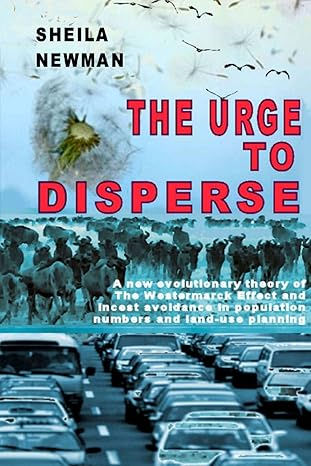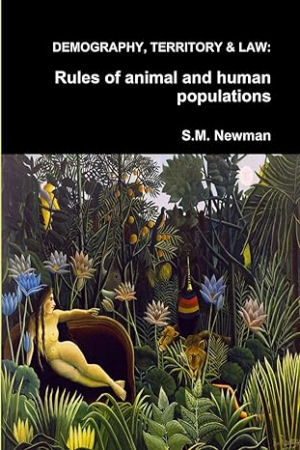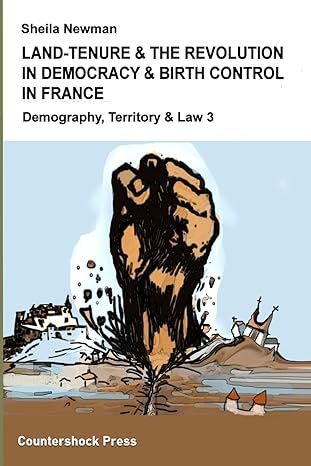 In the first book in the series, Demography, Territory and Law: The Rules of Animal and Human Populations, I argued that, under normal circumstances, human and other animal populations adjust naturally to comfortable levels within the carrying capacity of their environments. This runs contrary to much modern dogma, which suggests that overpopulation is inevitable and can only be combated with increasing production of goods and mitigated via modern contraception.
In the first book in the series, Demography, Territory and Law: The Rules of Animal and Human Populations, I argued that, under normal circumstances, human and other animal populations adjust naturally to comfortable levels within the carrying capacity of their environments. This runs contrary to much modern dogma, which suggests that overpopulation is inevitable and can only be combated with increasing production of goods and mitigated via modern contraception.
Using a theory I called "The Urge to Disperse," (in a book by the same name) I showed how the key to this adjustment was patterns of population distribution in space caused by the Westermarck Effect and incest avoidance. I cited abundant evidence that these effects are present in most and possibly all species. In anthropology these effects are known as land-tenure and 'kinship rules.' In law they are known as inheritance and property laws. In sociology they are known as land-use planning systems.[1]
I also suggested a mechanism whereby the strictness of these 'kinship rules' would adjust upwards or downwards according to environmental variations over regions, creating lower or higher fertility. This mechanism must be automatic because many non-human species have analogous rules. It is unlikely that non-humans make complex conscious calculations about carrying capacity and then respond by devising such codes of conduct. More probable is that hormones are a mediating factor between reliability of food availability and fertility. They might be thought of as a chemical messenger. Living creatures are biochemical systems which are regulated by hormones.
Not all hormones are concerned with sexual reproduction, of course. Hormones regulate absolutely all our functions, from appetite, sugar uptake and digestion, to sweating, tissue growth, body shape, muscle quality, and sexual maturity and sexual behaviour. Hormones are responsive to external and internal environmental conditions. Some hormonal responses are obvious and well known, such as the impact that spring has on reproduction in most living things – plant and animal – and the response of sexual attraction that occurs on encountering a prospective mate.
Studies in animals and in people show that hormones are also affected by the presence of close family. One of these effects seems to be the suppression of oestrus in the presence of close relatives, promoting incest avoidance. In the first volume of Demography, Territory and Law, I discuss relevant studies on acorn woodpeckers, marmosets, apes, and many more, including insects.

Based on the role of hormones described above and objective data from the animal studies, the hypothesis introduced in Volume 1 of this series is that hormones will deliver more or less fertility according to availability of living space. Space (territory) required per individual will be affected by density and reliability of food and water distribution, and all of this will be mediated by some degree of incest avoidance/Westermarck Effect, which is also related to social dominance. (Other forms of dominance such as caste and gender may also operate. Opportunities for meeting may also be limited by gender specific circuits and territories, which can themselves be seasonal. Availability of prospective mates will also be affected by who is already partnered and marriage rules like monogamy and polygamy.)
A minimum physical distance from blood relatives or 'in-laws' would be required before sexual activity becomes likely. If a subject who is of an age to reproduce is dominated (i.e. within the physical sway of a parent), ovulation and sexual maturity may actually be measurably chemically inhibited.
If algorithms of population spacing occur in other species they must be biologically and genetically based. Incest avoidance norms in our own species almost certainly arise from similar autonomic sources. As I have suggested, in studies of other species, there is good evidence that these algorithms adjust to hormonal responses to sensory and alimentary feedback from the environment where availability of territory may be measured by distance from close relatives. Potentially fertile offspring who are dominated by close relatives cannot find territory of their own and non-incestuous, non-Westermarck Effect opportunities for mating are not taken up. There is evidence that hormonal suppression also occurs in similar circumstances in humans.
Economic demography writers will usually acknowledge vaguely that natural fertility control processes must have existed prior to the agricultural revolution. An assumption follows that these processes have since been obscured, discontinued, or were never very effective. In this paradigm, a human population explosion began around the time that humans began using agriculture and another, much bigger explosion, began around the time of the industrial revolution. Theories about the reasons for the associated overpopulation and/or poverty began circulating even before Thomas Malthus.
Modern economic and political theory is based on the idea of natural laws of the past from which humans departed by forming a ‘social contract.’ Hobbes is famous for asserting that life without government, in a condition which he called the ‘state of nature’, would mean lives that were nasty, brutish, and short. He thus justified a hierarchical order as preventing people remaining in continuous ferocious competition with each other.
Other philosophers believed that these natural laws comported a peaceful stability. Anarchists like Bakunin and Prudhon wanted to return to old rhythms and scale of local communal society, which obviously provided opportunities for direct biofeedback. Marx and Engels, reacting to the poverty of masses in industrial capitalism, hoped to find some new stability through communism, but on a similar scale to capitalism. On this scale direct biofeedback was usually impossible and scale and factors like importation of food, distorted feedback.
John Locke derived his (capitalist) theory from his interpretation of natural laws, understood modern government as the outcome of conflicts arising from population pressures, but saw these as inevitable.
Underlying all these debates was competition for land. As land-use intensified and population grew, land that was once quietly inherited and used simply for living, was capitalised, and that capital became available to exploit more land. These ideas are developed in the first and second titles of the series Demography Territory Law, of which this book is the third. The development of capitalism is explored in the second volume, entitled, Demography Territory Law 2: Land-tenure and the Origins of Capitalism in Britain.
NOTES
The following is adapted from Appendix Three in Sheila Newman, Land-Tenure and the Revolution in Democracy and Birth Control in France, Countershock Press, 2024Note that this theory was first expressed in Sheila Newman, The Urge to Disperse, Candobetter Press, 2013

Add comment